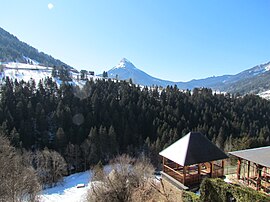|
Saint-Pierre-de-Chartreuse
Saint-Pierre-de-Chartreuse (French pronunciation: [sɛ̃ pjɛʁ də ʃaʁtʁøz]) is a commune in the Isère department in the Auvergne-Rhône-Alpes region in southeastern France.[3] It is located in the Chartreuse Mountains, to the north of the city of Grenoble. The Grande Chartreuse, the head monastery of the Carthusian order is located in Saint-Pierre-de-Chartreuse. GeographyThe village is located in the heart of the Chartreuse Mountains 25 kilometers north of Grenoble. EtymologyThe village was earlier known as Catorissium, Cantourisa, Caturissium, and Chatrousse.[4] The name is of Gaulish origin;[5] and is perhaps related to the name of the Caturiges tribe.[6] HistoryThe village is mentioned in the Tabula Peutingeriana under the name Catorissium, and in the Ravenna Cosmography as Cantourisa.[5] When St. Bruno and his six companions settled near Chartrousse in June 1084 on the indication of Bishop Hugues de Grenoble, they took the name of the nearby village and latinized it in Cartusia. Population
Media
EconomyEarly 20th centurySaint-Pierre-de-Chartreuse has lived of agriculture for a long time, like other mountain villages, and also of the wood trade, the forest being composed primarily of conifers. In the early 20th century, tourism took an important place, including the construction of the 'Grand Som' luxury hotel that hosted famous guests including Queen Victoria of the United Kingdom. The village was rated weather resort in the 1930s and people came here to recharge, visit the monastery of the Grande Chartreuse (which was open to the public between 1903 at the expulsion of the monks to 1940 at their return from Italy). It was also at St. Pierre that created first "Syndicat d'initiative" of France, now best known under the name "Office du Tourisme" (tourist information centee) and thanks to an Alsatian called Leon Auscher, who had adopted this country that was so dear to him. Between the wars, many families in the village engage in the hotel, the number of travellers grew. During this period, the first lift was born in the form of a sleigh pulled by a winch. The 1950s drove to the installation of the first teleported: the "télébenne". Since 1970The ski resort experienced the glory days of winter sports in the 1970s, and after suffering "years without snow" in the 1980s and early 1990s, it is currently experiencing a second wind. Snow is sometimes random and allows seasons of no more than three months, but the resort's strategic location near major urban centres (including Grenoble), the approximation of the neighboring station Planolet, the family atmosphere, and the affordable prices made it experience in 2005 and 2006 its largest turnover in terms of selling packages. Winter sports (mainly alpine skiing but Nordic skiing or snowshoeing) relate to the heart of the area, with 90 million euros per year, and they provide work to a large number of Chartroussins. Crafts are not left out, and the village is home to masons, stonecutters and carpenters. Tourism remains one of the very solid players of the Chartreuse Massif and the area. Many visitors come to discover the Grande Chartreuse monastery founded by St. Bruno in 1084 and especially the Museum of the Grande Chartreuse at the Correrie dedicated to it: 60,000 visitors a year. Shops include a bakery, butchery, supermarket, pharmacy, newsagent, cheese, bars, hotels, restaurants, sports shops and salon. Personalities
Events
SportsSkiThe Saint Pierre de Chartreuse / Le Planolet ski resorts include : 35 km of slopes, 4 black, 9 red, 5 blue and 6 green. 14 lifts, 1 gondola, 3 chairlifts and 10 lifts. The top of the resort is located at La Scia at 1791 m altitude. The bottom of the station is situated 900 m, a drop of almost 900 m. Depending on snow conditions, the resort features a snowpark (located on the old departure of the chairlift Battour), and various spots on the Scia (Big Air in the first ledge and various bumps on the last run of the track). You can access the station in three places. St Pierre de Chartreuse village, Combe de l'ourse chairlift parking, or Le planolet. on weekdays outside of school holidays, often combe de l'ourse is closed. Trail-RunningThe area surrounding St Pierre de Chartreuse is becoming increasingly popular as a trail-running destination, with several marked trails of varying length and difficulty. The ultra-running race "Le Grand Duc" (named after the Eagle Owl which is the symbol of the Parc Régional Naturel de Chartreuse) starts and ends in the village with a route which varies each edition. Sights
See alsoReferences
External linksWikimedia Commons has media related to Saint-Pierre-de-Chartreuse. |
||||||||||||||||||||||||||||||||||||||||||||||||||||||||||||||||||||||||||||




